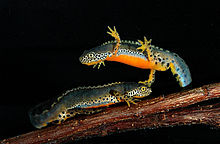
Back سمندر مائي Arabic أركنوز ARY Gweronell Breton Tritons Catalan Тритонсем CV Madfall ddŵr Welsh Molch German Τρίτωνας (αμφίβιο) Greek Trituro (amfibio) Esperanto Uhandre Basque
| Newt Temporal range:
| |
|---|---|

| |
| Alpine newt | |
| Scientific classification | |
| Domain: | Eukaryota |
| Kingdom: | Animalia |
| Phylum: | Chordata |
| Class: | Amphibia |
| Order: | Urodela |
| Family: | Salamandridae |
| Subfamily: | Pleurodelinae |
| Genera | |
A newt is a salamander in the subfamily Pleurodelinae. The terrestrial juvenile phase is called an eft. Unlike other members of the family Salamandridae, newts are semiaquatic, alternating between aquatic and terrestrial habitats. Not all aquatic salamanders are considered newts, however. More than 100 known species of newts are found in North America, Europe, North Africa and Asia. Newts metamorphose through three distinct developmental life stages: aquatic larva, terrestrial juvenile (eft), and adult. Adult newts have lizard-like bodies and return to the water every year to breed, otherwise living in humid, cover-rich land habitats.
Newts are threatened by habitat loss, fragmentation and pollution. Several species are endangered, and at least one species, the Yunnan lake newt, has become extinct recently.
- ^ Zhang, Peng; Papenfuss, Theodore J.; Wake, Marvalee H.; Qu, Lianghu; Wake, David B. (2008). "Phylogeny and biogeography of the family Salamandridae (Amphibia: Caudata) inferred from complete mitochondrial genomes" (PDF). Molecular Phylogenetics and Evolution. 49 (2): 586–597. doi:10.1016/j.ympev.2008.08.020. ISSN 1055-7903. PMID 18801447. Archived from the original (PDF) on 2017-02-02. Retrieved 2016-08-29.
© MMXXIII Rich X Search. We shall prevail. All rights reserved. Rich X Search